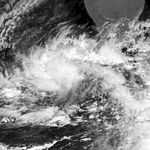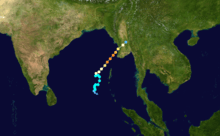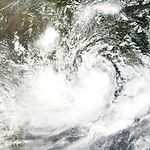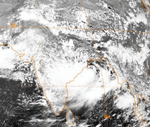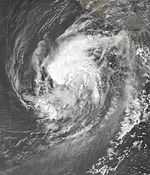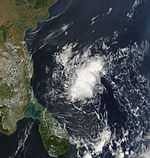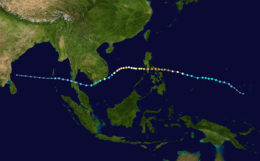2006 North Indian Ocean cyclone season
| |
| Season summary map |
| First system formed |
January 13, 2006 |
| Last system dissipated |
October 30, 2006 (Officially)
December 7, 2006 (Unofficially) |
| Strongest storm |
Mala – 954 hPa (mbar), 185 km/h (115 mph) (3-minute sustained) |
| Depressions |
12 official, 1 unofficial |
| Deep depressions |
6 |
| Cyclonic storms |
3 |
| Severe cyclonic storms |
2 |
| Very severe cyclonic storms |
1 |
| Total fatalities |
623 |
| Total damage |
At least $6.7 million (2006 USD) |
North Indian Ocean tropical cyclone seasons
2004, 2005, 2006, 2007, 2008 |
The 2006 North Indian Ocean cyclone season had no bounds, but cyclones tend to form between April and December, with peaks in May and November. These dates conventionally delimit the period of each year when most tropical cyclones form in the northern Indian Ocean.
The scope of this basin is north of the Equator and west of the Malay Peninsula. The IMD and JTWC monitor this basin. This basin is divided in two seas by India, the Bay of Bengal and Arabian Sea, abrriviated BOB and ARB, respectively.
Although an inactive year, 2006 had more of note than previous years like 2005 or 2004. Cyclone Mala caused severe damage and killed 22 when it hit Burma as a cat. 3. An unnamed depression killed over 100 in India, and cyclonic storm Ogni caused minor effects in India as well. Additionally, the remnants of Typhoon Durian crossed the Malay Peninsula causing minor effects, but was a rare basin-crosser in this area.
Season summary

Overall activity across the North Indian Ocean during 2006 was slightly below-average, with 12 depressions, 3 cyclonic storms, and 1 very severe cyclonic storm. An average season, according to the IMD, consists of 15 depressions and 5–6 cyclonic storms.[1] In addition to the storms monitored by the IMD, the JTWC also tracked the remnants of Typhoon Durian across the Malay Peninsula into the Andaman Sea as a tropical depression in early December.[2] The majority of storms formed within the Bay of Bengal, with only two existing in the Arabian Sea. Activity peaked during the summer due to an active southwest monsoon.[1][3]
Starting in May, the seasonal monsoon developed over the Bay of Bengal and advanced northwestward over India where it propagated through September. During this period the system spawned numerous disturbances, nine of which became tropical cyclones. All but one of these systems formed in the northern Bay of Bengal and struck Odisha before spreading rain across large portions of India. The outlier was Severe Cyclonic Storm Mukda in late September which remained virtually stationary its entire existence to the southwest of Gujarat.[3] The combined effects of the eight other depressions along with the monsoon itself caused disastrous flooding throughout India. By early August, nearly 500,000 people were evacuated in Mumbai due to rising waters.[4] The collective effects of the depressions alone resulted in at least 562 fatalities with hundreds more attributed to the monsoon rains.[1] More than 1 million people across Odisha were left homeless from the storms.[5]
During periods of cyclonic activity, rainfall associated with the monsoon was above-average as a whole. Departures from average reached 13.8%, 26.2%, 28.1%, 9.8%, and 11.5% for the periods of July 5–12 (BOB 02), August 2–9 (BOB 03), August 9–16 (BOB 04), September 20–27 (Land 01 and Mukda), and September 27–October 5 (BOB 08), respectively.[1][3] In contrast to the notable activity of the monsoon in respect to tropical cyclone formation, rainfall from the monsoon across India was predominantly below-average due to poor distribution of rain. Of the four broadly defined regions of India used by the IMD, only Central India experienced above-average rainfall, possibly due to the multiple cyclones that passed through the region. This area received an average of 1,152.2 mm (45.36 in) of rain between June and September, while the average is 993.9 mm (39.13 in). In addition, five sub-divisions (the Andaman and Nicobar Islands, Arunachal Pradesh, Assam and Meghalaya, west Uttar Pradesh, and Haryana) experienced drought conditions.[3]
Storms
Deep Depression ARB 01
| Deep depression (IMD) |
| Tropical storm (SSHWS) |
|
|
| Duration |
January 13 – January 14 |
| Peak intensity |
55 km/h (35 mph) (3-min) 1004 mbar (hPa) |
On January 13, an area of convection organized into Tropical Cyclone 01A to the southwest of the southern tip of India. Shortly after forming, conditions quickly became unfavorable, and the storm dissipated on January 14 over open waters.
Very Severe Cyclonic Storm Mala
| Very severe cyclonic storm (IMD) |
| Category 4 tropical cyclone (SSHWS) |
|
|
| Duration |
April 25 – April 29 |
| Peak intensity |
185 km/h (115 mph) (3-min) 954 mbar (hPa) |
Main article:
Cyclone MalaIn mid-April, an area of disturbed weather formed over the southern Bay of Bengal and nearby Andaman Sea. Over a period of several days, the system became increasingly organized and was classified as a depression on April 24. Situated within a region of weak steering currents, the storm slowly intensified as it drifted in a general northward direction. It attained gale-force winds and was named Mala the next day. Conditions for strengthening improved markedly on April 27 and Mala subsequently underwent rapid intensification which culminated in the cyclone attaining its peak. Early on April 28, the cyclone had estimated winds of 185 km/h (115 mph) and a barometric pressure of 954 mbar (hPa; 28.17 inHg).[6] The JTWC considered Mala to have been slightly stronger, classifying it as a Category 4-equivalent cyclone.[7] Steady weakening ensued thereafter and the storm made landfall in Myanmar's Rakhine State on April 29. Rapid dissipation took place once onshore and Mala was last noted early the next morning.[6]
In contrast to Mala's intensity, damage was relatively minimal across Myanmar due to adequate early warnings, while timely and effective evacuations minimized loss of life along the coast.[8] The greatest damage resulted from a thunderstorm near Yangon on April 28 that spawned a possible tornado in an industrial zone. A total of 586 homes were damaged there.[9] Just outside the city in the Hinthada District, a flash flood killed at least 18 people.[8] Overall, the storm claimed 37 lives in the country and left US$6.7 million in damage.[10][11][12] In the wake of Mala, the Red Cross distributed relief aid to affected residents while local officials set up shelters to house those left homeless.[13] Government and social organizations donated 5.4 million kyat (US$4,320) in cash to survivors in the Ayeyarwady Region.[14][15]
Deep Depression BOB 02
| Deep depression (IMD) |
| Tropical storm (SSHWS) |
|
|
| Duration |
July 2 – July 5 |
| Peak intensity |
55 km/h (35 mph) (3-min) 982 mbar (hPa) |
In late June, an area of disturbed weather persisted over the northern Bay of Bengal, unusually far south for a monsoonal system for this time of year. Convergence from the monsoon enhanced convection to the southwest of a developing low-pressure area; however, strong wind shear was expected to prevent tropical cyclogenesis. In contrast to this the system rapidly organized into a deep depression by July 2, at which time it was situated 240 km/h (150 mi) south of Calcutta, India.[16] At 1200 UTC, the JTWC classified the cyclone as a tropical storm with one-minute sustained winds of 65 km/h (40 mph).[17] This marked only the second time since 1981 that the JTWC had monitored a storm with gale-force winds in the basin.[16] Weak steering currents prompted the a slow, westward track and just three hours later, the cyclone made landfall between Paradeep and Chandabali in Odisha.[18] A pressure of 982 mb (hPa; 29.00 inHg), the lowest in relation to the storm, was measured in Bhubaneswar as the deep depression moved through.[16] Once onshore, steady weakening took place and the depression ultimately degenerated into a remnant low on July 5 over Vidarbha.[18]
Owing to the cyclone's monsoonal nature, it produced heavy rains across a large swath of India and encompassed both coastlines. The heaviest rains fell in Odisha and Gujarat, with many areas receiving over 300 mm (12 in). A two-day total of 630 mm (25 in) was measured in the Nabarangpur district and many nearby areas reported over 500 mm (20 in). Ahwa, Gujarat, recorded the greatest single-day total of 390 mm (15 in), and received at least 540 mm (21 in) during the entire event. The hardest hit areas were Odisha and Vidarbha, where 36 and 41 people were killed, respectively.[18] At least five of the deaths were from fishermen who drowned offshore while the others resulted from landslides or building collapses.[19] In the nearby states, Andhra Pradesh, Jharkhand, Karnataka, a further 30 people were killed collectively from flooding and mudslides. The normally slow-moving Saglana River burst its banks in Bhavnagar, Gujarat, and left most of the city submerged. Several homes collapsed and power supply became erratic. At least two people lost their lives in the city.[20] A further 24 people were killed in the Navsari district after two rivers flooded surrounding areas.[21]
Deep Depression BOB 03
| Deep depression (IMD) |
|
|
| Duration |
August 2 – August 5 |
| Peak intensity |
55 km/h (35 mph) (3-min) 986 mbar (hPa) |
A low pressure area formed over northwest Bay of Bengal off West Bengal and Orissa coasts in the evening of 01st August and concentrated into Deep Depression the next day. It crossed the south Orissa coast between Puri and Gopalpur in the
morning of 3rd August. In 48 hrs between 3 and 4th August, Pottangi in Orissa got 520 mm rainfall. In total 251 people lost their lives due to the floods caused by the Depression. [22]
Depression BOB 04
| Depression (IMD) |
|
|
| Duration |
August 12 – August 13 |
| Peak intensity |
45 km/h (30 mph) (3-min) 992 mbar (hPa) |
A low pressure area formed over northwest Bay of Bengal in the evening of 11th August and it intensified into a depression over on 12th August and crossed Orissa coast close to Balasore on the same day. In 48 hrs between 12 and 13th August, Bijepur in Orissa got very heavy rainfall of 480 mm. The Depression also caused widespread flooding and 78 people lost their lives. [23]
Depression BOB 05
| Depression (IMD) |
|
|
| Duration |
August 16 – August 18 |
| Peak intensity |
45 km/h (30 mph) (3-min) 988 mbar (hPa) |
A low pressure area formed over northwest Bay of Bengal on 15th August. It concentrated into a depression on 16th August and crossed the Orissa coast close to Chandbali on the same day. Athagarh in orissa got 240 mm in 48 hrs between 16 & 17th August. The flooding killed around 48 people in India. [24]
Depression BOB 06
| Depression (IMD) |
|
|
| Duration |
August 29 – September 1 |
| Peak intensity |
45 km/h (30 mph) (3-min) 990 mbar (hPa) |
It was the fourth depression to form in one month. A low pressure area over northwest Bay of Bengal on 27th August intensified into a depression on 29th August and crossed the Orissa coast near Paradip around noon in the same day. In 48 hrs, Baliguda in Orissa got 510 mm rainfall between 29 and 30th August. Floods in Madhya Pradesh took a toll of 9 lives. [25]
Depression BOB 07
| Depression (IMD) |
|
|
| Duration |
September 3 – September 4 |
| Peak intensity |
45 km/h (30 mph) (3-min) 992 mbar (hPa) |
A low pressure area formed over northwest Bay of Bengal on 2nd September. It concentrated into a depression the next day and crossed the north Orissa coast near Chandbali in the early morning of 4th September. Govindpur in Orissa recorded 150 mm rainfall on 4th September. [26]
Land Depression 01
| Depression (IMD) |
|
|
| Duration |
September 21 – September 24 |
| Peak intensity |
45 km/h (30 mph) (3-min) 996 mbar (hPa) |
The India Meteorological Department upgraded a well-marked low pressure area near Jamshedpur, India to a land depression with minimum pressure 996hPa and maximum sustained winds of 25 knots (46 km/h) on September 21.[27] The United States Naval Research Laboratory previously monitored the system as an area of interest before it moved inland near the border of India and Bangladesh. The depression degenerated into a low pressure area on September 24 and dissipated later that day. Torrential downpours caused flooding that killed more than 170 people and left around 375,000 homeless in eastern India and Bangladesh. Tantloi in West Bengal got 370 mm in 48 hrs between 22 and 23rd September.[28]
Severe Cyclonic Storm Mukda
| Severe cyclonic storm (IMD) |
| Tropical storm (SSHWS) |
|
|
| Duration |
September 21 – September 24 |
| Peak intensity |
100 km/h (65 mph) (3-min) 988 mbar (hPa) |
An area of disturbed weather in the Arabian Sea was classified as Tropical Cyclone 04A by the Joint Typhoon Warning Center on September 21. The India Meteorological Department began monitoring the system as a deep depression later that day, and designated it Cyclonic Storm Mukda early on September 22. Mukda slowly and erratically meandered to the northeast and intensified into a severe cyclonic storm later that day. On September 24, Mukda weakened into a depression under increasing wind shear. The remnant circulation lingered for four more days before dissipating on September 28. Mukda was never forecast to make landfall. Upleta in Gujarat got 100 mm rainfall on 25th September.[29]
Depression BOB 08
| Depression (IMD) |
| Tropical storm (SSHWS) |
|
|
| Duration |
September 28 – September 30 |
| Peak intensity |
45 km/h (30 mph) (3-min) 1002 mbar (hPa) |
Tropical Cyclone 05B formed on September 28 approximately 250 nautical miles (460 km) south of Kolkata, India. It made landfall on September 29 near Gopalpur, Odisha before dissipating overland. Mahendragarh in Orissa got 170 mm rainfall on 30th September. [30]
Cyclonic Storm Ogni
| Cyclonic storm (IMD) |
| Tropical storm (SSHWS) |
|
|
| Duration |
October 29 – October 30 |
| Peak intensity |
65 km/h (40 mph) (3-min) 988 mbar (hPa) |
On October 29, a deep depression that had formed in the past day off the coast of Andhra Pradesh strengthened and was named Ogni, a name contributed by Bangladesh. It weakened back into a deep depression on October 30 and made landfall near Bapatla at around 1300 IST (0730 UTC). The system was numbered as TC 06B in JTWC post-analysis.[31]
At least 35 people were killed by record rainfall between 28th October and 4th November during which Avanigadda and Machilipatnam in Andhra Pradesh got 1030 mm and 990 mm respectively. In 24 hrs period Gudivada got 550 mm rainfall on 31st October and in 48 hrs period between 30 and 31st October Avanigadda got 670 mm rainfall.[32] [33]
Ogni was the smallest tropical cyclone on record in the North Indian Ocean.[34]
Tropical Depression Durian
| Tropical depression (SSHWS) |
|
|
| Duration |
December 5 (entered basin) – December 7 |
| Peak intensity |
35 km/h (25 mph) (1-min) 1004 mbar (hPa) |
Main article:
Typhoon DurianOn December 5, the Japan Meteorological Agency and the Joint Typhoon Warning Center reported that a weakening Tropical Depression Durian had moved into the Andaman Sea.[35] However the Indian Meteorological Department did not release any warnings or assign a BOB designation.
Season effects
This is a table of all storms in the 2006 North Indian Ocean cyclone season. It mentions all of the season's storms and their names, durations, peak intensities (according to the IMD storm scale), landfall(s) – denoted by areas in parentheses – damages, and death totals. Damage and death totals include the damage and deaths caused when that storm was a precursor wave or extratropical low, and all of the damage figures are in 2006 USD.
See also
References
- ↑ 1.0 1.1 1.2 1.3 Report on Cyclonic Disturbances Over North Indian Ocean During 2006 (PDF) (Report). India Meteorological Department. January 2007. Retrieved May 18, 2014.
- ↑ "Super Typhoon 24W (Durian) Best Track" (.TXT). Joint Typhoon Warning Center. United States Navy. 2007. Retrieved May 18, 2014.
- ↑ 3.0 3.1 3.2 3.3 "Southwest Monsoon 2006 End-of-Season Report". India Meteorological Department. 2006. Archived from the original on May 18, 2014. Retrieved May 18, 2014.
- ↑ "Half a million homeless in India floods, Mumbai hit". Reuters. ReliefWeb. August 6, 2006. Retrieved May 18, 2014.
- ↑ "One million made homeless by floods in India - Concern responds". Concern Worldwide. ReliefWeb. September 6, 2006. Retrieved May 18, 2014.
- ↑ 6.0 6.1 "Very severe cyclonic storm "Mala" over the Bay of Bengal 25-29 April 2006". Report on Cyclonic Disturbances Over North Indian Ocean During 2006 (PDF) (Report). India Meteorological Department. January 2007. pp. 22–26. Retrieved May 19, 2014.
- ↑ "Tropical Cyclone 02B (Mala) Best Track" (.TXT). Joint Typhoon Warning Center. United States Navy. 2007. Retrieved May 19, 2014.
- ↑ 8.0 8.1 Myanmar: Cyclone Mala Final Report for DREF Bulletin no. MDRMM01 (PDF). International Federation of Red Cross and Red Crescent Societies (Report) (ReliefWeb). February 15, 2007. Retrieved May 6, 2014.
- ↑ "Cyclone Mala kills two in Burma". The Nation (Yangon, Myanmar). Associated Press. May 1, 2006. p. 4A. Retrieved May 6, 2014.
- ↑ "Myanmar: 2006 Progress Report" (PDF). International Federation of Red Cross And Red Crescent Societies. ReliefWeb. December 31, 2006. Retrieved May 8, 2014.
- ↑ Ministry of Social Welfare, Relief and Resettlement and the Ministry of Education (2008). "Natural Disasters in Myanmar". Guidance on Mainstreaming Disaster Risk Reduction in the Education Sector, Myanmar - Rural Settings (PDF). Myanmar Information Management Unit. p. 16. Retrieved May 7, 2014.
- ↑ Tint Zaw and Mu Mu Than (March 2010). "Climate Change Impacts to the Water Environment and Adaptation Options" (PDF). Union of Myanmar Ministry of Agriculture and Irrigation. Water Environment Partnership in Asia. p. 9. Retrieved May 7, 2014.
- ↑ "Myanmar: Cyclone Mala Information Bulletin No. 1". International Federation of Red Cross And Red Crescent Societies. ReliefWeb. May 3, 2006. Retrieved May 6, 2014.
- ↑ "Myanmar: Commander, Minister donate relief supplies to cyclone victims in Ayeyawady Division". Government of Myanmar. ReliefWeb. May 1, 2006. Retrieved May 6, 2014.
- ↑ "Myanmar: Relief provided to cyclone victims". Government of Myanmar. ReliefWeb. May 3, 2006. Retrieved May 6, 2014.
- ↑ 16.0 16.1 16.2 Gary Padgett and Kevin Boyle (October 3, 2006). "July 2006". Monthly Global Tropical Cyclone Summary (Report). Australia Severe Weather. Retrieved May 18, 2014.
- ↑ "Tropical Cyclone 03B Best Track" (.TXT). Joint Typhoon Warning Center. United States Navy. 2007. Retrieved May 18, 2014.
- ↑ 18.0 18.1 18.2 "Deep depression over Bay of Bengal July 2-5, 2006". Report on Cyclonic Disturbances Over North Indian Ocean During 2006 (PDF) (Report). India Meteorological Department. January 2007. pp. 27–33. Retrieved May 18, 2014.
- ↑ "Indian rains take heavy toll". Bombay, India. United Press International. July 6, 2006. – via Lexis Nexis (subscription required)
- ↑ "Monsoon rains cause flood, destruction in Gujarat". Hindustan Times (Bhavnagar, Gujarat). July 6, 2006. – via Lexis Nexis (subscription required)
- ↑ "Rains Claim 24 More Lives In India, Nationwide Toll Rises To 274". Qatar News Agency (Doha, Qatar). July 6, 2006. – via Lexis Nexis (subscription required)
- ↑ http://www.imd.gov.in/section/nhac/dynamic/RSMC%20-2006.pdf
- ↑ http://www.imd.gov.in/section/nhac/dynamic/RSMC%20-2006.pdf
- ↑ http://www.imd.gov.in/section/nhac/dynamic/RSMC%20-2006.pdf
- ↑ http://www.imd.gov.in/section/nhac/dynamic/RSMC%20-2006.pdf
- ↑ http://www.imd.gov.in/section/nhac/dynamic/RSMC%20-2006.pdf
- ↑ http://www.wmo.ch/pages/prog/www/tcp/documents/PTC34_final_report.pdf Archived 19 December 2010 at WebCite
- ↑ http://www.imd.gov.in/section/nhac/dynamic/RSMC%20-2006.pdf
- ↑ http://www.imd.gov.in/section/nhac/dynamic/RSMC%20-2006.pdf
- ↑ http://www.imd.gov.in/section/nhac/dynamic/RSMC%20-2006.pdf
- ↑ TROPICAL CYCLONE (TC) 06B Archived 19 December 2010 at WebCite
- ↑ M M Nayak (2007). "Cyclone Ogni". Andhra Pradesh Disaster Management. Archived from the original on December 19, 2010. Retrieved April 15, 2009.
- ↑ http://www.imd.gov.in/section/nhac/dynamic/RSMC%20-2006.pdf
- ↑ "Frequently Asked Questions: Which are the largest and smallest tropical cyclones on record?". India Meteorological Department. 2013. Retrieved May 19, 2014.
- ↑ http://www.usno.navy.mil/NOOC/nmfc-ph/RSS/jtwc/best_tracks/2006/2006s-bwp/bwp242006.txt
- ↑ "Cyclonic storm "Ogni" over the Bay of Bengal October 29-30, 2006". Report on Cyclonic Disturbances Over North Indian Ocean During 2006 (PDF) (Report). India Meteorological Department. January 2007. pp. 78–83. Retrieved May 18, 2014.
- ↑ "`Ogni' crop damage runs up to 1,600 cr". The Hindu. November 8, 2006. Retrieved May 19, 2014.
- ↑ "35 killed in AP cyclone Ogni". Associated Press. CNN IBN. November 6, 2006. Retrieved May 19, 2014.
External links
|
|---|
| | | |
-
 Book Book
-
 Category Category
-
 Portal Portal
-
 WikiProject WikiProject
-
 Commons Commons
|
|
| 2000–2009 North Indian Ocean cyclone seasons |
|---|
| |
|


